
|   |

|   |
 e-mail: sunilkothari1933@gmail.com Tharang Utsav and Trivandrum diary December 21, 2017 5th edition of Tharang Utsav Aparna Vinod Menon has been conducting Tharang Utsav for the past four years in Bangalore. Besides showcasing the senior established dancers, Tharang offers platform to young dancers to encourage them and also show their young students the high standards of senior and young dancers. Besides being fond of classical Hindustani music, and studying under the renowned Bengali vocalist Rina Basu, a disciple of Chinmay Lahiri, guru of Parveen Sultana, Tharang also presents up and coming Carnatic vocal and instrumental musicians. Her young son Siddharth has been studying classical Hindustani vocal from Rina Basu. The first day's program at JSS Hall in Jayanagar began with a prayer rendered by him. He has a melodious voice and shows promise to be a competent musician. Aparna has a chequered career. A qualified MBA, she gave it up to study Bharatanatyam as a career. Ten years ago, she moved with her husband to Bangalore and started studying under Bhanumati. She also met Odissi exponent Sharmila Mukerjee who encouraged her to start teaching Bharatanatyam to young students. Later on, with assistance and support of local dancers, she planned the two day dance and music festival Tharang Utsav. Aparna presented Pushpanjali in Arabhi along with her four disciples. The enactment of story of Lord Ganapati not permitting Lord Shankara to enter the house, enraged the lord who cut off his head. Seeing that, Parvati appealed to the lord to restore life to Ganapati. The head of an elephant was brought and placed on Ganapati's body. The stuti in praise of Ganapati describes his attributes as remover of all obstacles and mouse as his vehicle. The group formed the iconic image with Ganapati's trunk, his swaying large ears, with his vehicle in front. The choreography was neat as was their uniform technique. Set to raga Bageshri, in solo rendering of Gita Govinda ashtapadi, 'Samudita ramaniya vadane, ramate Yamunakule,' Radha's disappointment at seeing Krishna's dalliance with other gopis was portrayed by Aparna with restraint. The understated rendition as taught to her by Bhanumati was projected artistically. Krishna's beauty, decorations with various flowers and ornaments were enacted with precision. Extending her repertoire using classical Dhrupad and composition of Tansen, Aparna wove a narrative of how a jealous musician managed to get the king to ask Tansen to sing Deepak raga and see the miracle of lamps with light coming alive. Tansen knew that rendering it would cause him agony. But to his rescue came his daughter who afterwards made him sing Megh Malhar raga which brought rains and with that the burning feelings caused by rendering Deepak raga were assuaged. Aparna needs to show it for some more time instead of immediately showing his rendering Megh Malhar raga and other dancers showing rains. However, the episodic presentation was interestingly rendered. The finale tillana with her disciples had a seamless flow, the dancers forming various centripetal formations, chain formation and circle. It was neat in terms of choreography and visual appeal. The music by Srivatsa with his sonorous voice embellished the dance numbers. 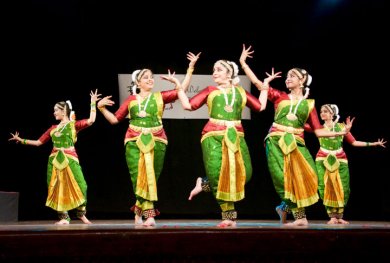 Aparna Vinod and group  Shivaranjini and Rasika Kiran Two sprightly young dancers Shivaranjini and Rasika Kiran, daughter/disciple of Guru Kiran and his wife Sandhya impressed the audience with their sparkling Bharatanatyam. Their duet dancing was in perfect sync. The prayer in praise of Ganapati followed by prayer in praise of Lord Shiva wove in the episode of the lord drinking poison when the churning of the ocean took place. But Parvati pleaded with him and it stopped at his neck, hence Shiva is described as Nilakanta. Their duet dancing was pleasant and it was obvious that their scheduling in the festival was to present them as role model for young students of Tharang Academy. Another dancer who impressed me the most was Srividya Angara, disciple of Vijayavalli Priya, trained at Telugu University. Srividya has a commanding stage presence and performs with lilting grace highlighting the distinct style of Kuchipudi. She chose Mandodari Sabdam which had old world charm. The refrain Rajadhiraja vira pratap shri Krishna Devaraya and the way salutation was employed pointed at how Kuchipudi had incorporated the salutation. The vachikabhinaya, the onomatopoetic rendering of syllables for frog, Ravana's entry, Mandodari's abhinaya showing bashfulness at Ravana holding her hand, et al were performed keeping the flavor of Kuchipudi intact. Rendered in Mohana Kapi raga and adi tala it was performed with zest and commendable stamina. In Tarangam performing to the refrain Kalay Krishna, Srividya wove episode of Radha's jealousy towards flute as it always rests on Krishna's lips. Krishna assures Radha that it is not the flute but Radha's kiss that he treasures most. The dancing on brass plate matched the mnemonics of mridangam and execution of various pada bhedas was flawless. 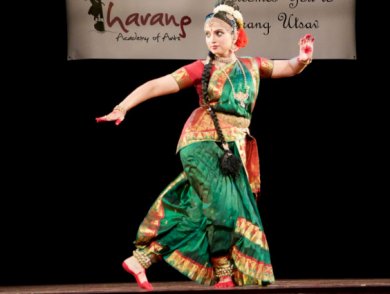 Srividya Angara 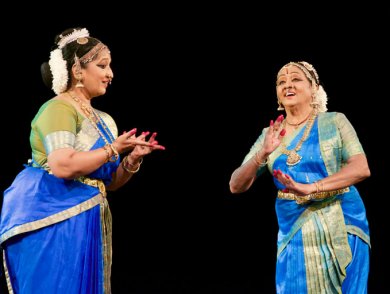 Sheela Chandrasekhar & Bhanumati The audience was looking forward to new choreographic work by Bhanumati based on Haridasa and Purandaradasa's compositions which dealt with social evils and how the saint poets had spelt them out 400 years ago. Srivatsa had assisted Bhanumati along with scholar Vidya in selecting the verses and setting tunes for the same. Bhanumati, her sister-in-law Sheela Chandrasekhar and two other dancers performed it in a succinct manner with use of lokadharmi abhinaya, to communicate the content which is even today socially relevant. The upper class Brahmin cursing the low caste shudras by accidently touching them after bath, the gossips, jealousy, greed, lust, were enacted in simple manner. The fake sadhus, godmen, were depicted by Bhanumati in a remarkable manner. The message as reflected in all the songs of Dasa poets was loud and clear. The social evils continue to plague us even in this time and age. The finale was apt with Purandaradasa's popular song Tamburi rendered by Kannada speaking people collectively. Chandrasekhar's commentary in English helped non Kannada audience grasp the content of the songs. Both abhinaya and choreography by Bhanumati, Sheela Chandrasekhar and other two dancers was extremely communicative. The audience gave them a standing ovation. It was a very refreshing thematic content and touched the hearts of all present. Bhanumati deserves congratulations for handling such a theme competently. And it should be presented more often so that it will dispel a wrong notion that Bharatanatyam is limited to only routine fare of padams and javalis. The next day on Dec 3, 16 year old Praneetha Sharma rendered few compositions in Carnatic raga, accompanied by a 10 year old girl on violin. It was quite impressive taking into account their young age. I was told that Praneetha's father is a renowned musician. The inclusion of these two young musicians in the festival was praiseworthy. The young children in the audience were very pleased to listen to these young artistes performing with such confidence. Divya Ravi, a bright young Bharatanatyam dancer took to the stage with aplomb. Currently under training of Soundarya Srivatsa, Divya's nritta was arresting with straight lines, geometric precision, and maintaining rhythm. Her jumps were perfect and she was brimming with youthful excitement, completing her movements dot on time. In her opening number Pushpanjali in Rajasthani Manda raga and adi tala her sparkling dance was captivating. Adi Shankaracharya's Sharada stotra offered her scope to etch iconic figures of Saraswati playing veena with beauty that enchants the universe, Jaganmohanangi, expert in dancing nrityaprabhangi, bhaje Sharadamba, and devotees worshipping the goddess. In central piece Lalgudi's Navaragamalika Varnam, Divya gave ample proof of her expertise describing the nine sentiments, Navarasa, as experienced by Parvati, taking various episodes and her reactions. Shringara showing her with Lord Shiva; adbhuta, wonderment, at destroying Tripurarasura; hasya, funny looking at Lord Shiva working as a construction labourer (this I saw for the first time); bibhatsa, disgust, as Sati's father insulted Lord Shiva; raudra, ferocious, at killing Bhanasura; bhaya, fear at Shiva's drinking poison; karuna, compassion for devotees and so on, Divya was in form. Whatever she danced, on that evening was joyous and enjoyable. Soundarya Srivatsa has all the reasons to be proud of taking her under her wings. The vocal music by Rina Basu was of a high order. A seasoned musician with sound training under legendary musicians like Chinmaya Lahiri, she has a melodious voice much cultivated over years. Beginning with Puriya Kalyani in vilambit ekatala and another bandish in druta, with various taans she displayed her mastery over the idiom. She followed it by raga Kedar in druta ekatala excelling in its rendition. She concluded her recital with a Meera bhajan. A senior musician, she needs further exposure on all India level. 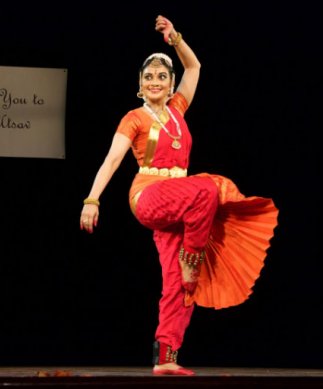 Divya Ravi 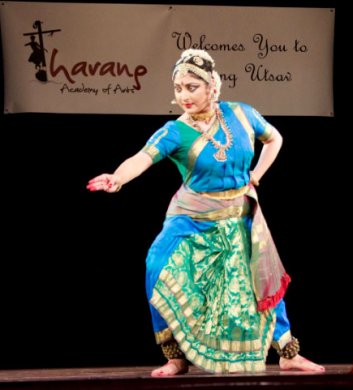 Lakshmi Gopalaswamy The much awaited Bharatanatyam recital by Lakshmi Gopalaswamy began in right earnest after the guests were honoured. Lakshmi has received training under several gurus including Padmini Ramachandran and late Narmada. She has assimilated it smoothly creating her own inimitable style. She has everything going good for her. Stage presence, beauty, youth, and commendable command over tala and rhythm, mobile visage registering bhavas in quick succession and fame as a gifted film actor all add to make her recitals highly enjoyable. She opened her recital with a shloka from Natyashastra she had studied under Bhanumati in praise of Rangadhi devata. The Jatigalu, an unusual number, was full of punch. Then she performed Muthiah Bhagavatar's varnam in Khamas raga and adi tala revealing her proficiency in pure dance and abhinaya with arresting teermanams which won her rounds of applause. The piece in praise of universal mother Parvati with refrain of Mate Malayadhwaja Pandyasanjate, was taken as a take off point to depict the Goddess's multiple incarnations, as Chamundeshwari, Mahishasuramardini in her fierce temperament, in beatific form as Sakalakalanipuna, expert in all arts, shining in entire universe Sakalabhuvane, surrounded by moon. Lakshmi unleashed her prowess in abhinaya and cascades of teermanams. Indeed a memorable number that mesmerized the audience. In contrast to that item, the padam in Navroz raga delineating the love her Lord has for her, Lakshmi depicted swadhinapatika nayika. Confident of love, ignoring other women's comments on where was he, who claimed he cannot keep his eyes off her face, welcoming her beloved with passion and feeling of gratitude and requesting beloved not to waste time and be together before the dawn breaks, and chirping of the birds starts. Swati Tirunal's composition ended with prayer to Pannagendrashayane Shri Padmanabhaswami. Another Hindi pada of Swati Tirunal set to Pilu raga was performed showing Krishna playing on bank of river Yamuna. His description as a divine God, with flute in his hands, peacock feather crown on his head, and cows, birds all mesmerized listening to his flute, Lakshmi enacted with natural ease. She could not resist performing an edited tillana that was not only lilting but also fast paced. A gifted dancer, she had Soundarya Srivatsa conducting nattuvangam with Nandakumar singing and Srihari on mridangam that embellished her performance. With humility and transparent sincerity Lakshmi won her audiences with excellent Bharatanatyam exposition. The two day Tharang Festival had full house on both days. Vinod Menon conducted the festival with well prepared introductions of the artists and musicians. I would suggest that for the 6th edition of Tharang Utsav, they should bring out, finance permitting, a brochure which will serve as document and a record for their activities. Trivandrum diary The morning flight to Trivandrum was bumpy and rather scary but the visit was rewarding. I was there in January for Nishagandhi Festival and had an opportunity to meet Madhu Gopinath and Sajeev of Samudra group. Also I had visited Daksha Sheth's Natyashrama at Nemon set in an ideal place, most conducive for creating new choreographic works. However coming to Trivandrum from Delhi we were met with heavy rains, winds, cyclone Ockhi which caused disaster. The Government announced about the possibility of cyclone and to avoid coastal area as the cyclone was moving in that direction towards Kanyakumari. Schools were closed and alert signal was given. In December, sometimes Kerala has rains but this December it seemed to have worst of rains and storm, including Ockhi. Several lives were lost. Community of fisher folk suffered the most. Some of them protested as the alert warning was not given in advance. Even after Tsunami, department of management of disaster has not woken up to alert people in advance. A pity! 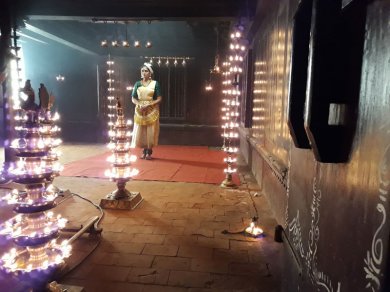 Sunanda Nair
Sunanda Nair was having a shooting for a documentary made on her by the renowned film director Vinod Mankara. His films Kamboji and Priyamanasam have received critical appreciation. Latter film is in Sanskrit. He has won national award for his film on Mohiniattam and is quite an authority on the dance form. I was invited to watch the shooting and also speak on Mohiniattam and dancer Sunanda Nair, whom I have known for many years when I was in Mumbai. Under guidance of Kanak Rele, she had shown commendable progress and by fortuitous coincidence, she even resembles Kanak Rele! Often people used to ask Kanak Rele if Sunanda was her daughter. I used to present young dancers at Kal-ke-Kalakar festival in Mumbai at C.J Hall where now there is National Gallery of Modern Art. I used to also conduct dance demonstrations with help from gurus like Kelucharan Mohapatra, Vempati Chinna Satyam, Bipin Singh, Krishna Panicker, Lachhu Maharaj, Kalyanasundaram and others. For Mohiniattam, I used to invite Kanak Rele as she was studying it under Rajalakshmi from Kerala Kalamandalam and was attached to Nalanda College. Often Kanak Rele used to invite her students to accompany her, including Sunanda, who started her own institution Sunanda Performing Arts Centre (SPAC) and trained several young dancers. After her marriage she moved to Houston in USA and opened SPAC, teaching Mohiniattam to local dancers. She told me that she is to give viva voce examination in January 2018 for PhD in Mohiniattam. The shooting venue was a former wooden mansion with typical Kerala architecture. It is said that the legendary Mohiniattam dancer Sugandhavalli used to stay there. Director Vinod Mankara had created an excellent setting. Using natural light of some six tall lamp posts lit up with wicks, Sunanda was performing Irayimman Thampi's padam in a temple like setting. Few crew members were continuously pouring oil and the place was lit up in golden hue with thousand flames - deepams. There was a trolley shot to be taken and camera moved on rails going closer to Sunanda. Somehow the focus was not correct and many retakes were taken. The heat generated by the flames was quite high. And I admired Sunanda's patience to repeat the abhinaya to the padam in praise of Krishna. It was quite magical. Vinod Mankara had sent me an email to find out if during my researches and visits to Kerala Kalamandalam in 1966 and later on, if I had come across any photograph of the first Mohiniattam dancer who taught at Kerala Kalamandalam. I had not. I had met Chinammu Amma and had her photos with Vyjayantimala. Also of Kalyani Kutty Amma, wife of Kalamandalam Krishnan Nair, the great Kathakali asan. And Thangamani, wife of Guru Gopinath. Vinod had interviewed the daughter of that first Mohiniattam dancer at Palakkad. She was then 98 years old and Vinod said that she still had some memories of her mother performing Mohiniattam. We spoke of one Mohiniattam dancer whom poet Vallathol had sent to teach Mohiniattam at Shantiniketan at request of Gurudev Rabindranath Tagore. Shantidev Ghosh, disciple of Gurudev had mentioned her visit to Shantiniketan but had not mentioned her name in his writings. When I had visited Kerala Kalamandalam in 1966, I had seen few young dancers learning Mohiniattam but did not know who was teaching them. In later years I had met Satyabhama, Leelamma and also Kshemavathy. It was heartening to learn from Vinod about the film he has made on Mohiniattam, which has won national award. Next day, Soorya Krishnamurty invited us to visit his residence. It is like a temple. He has received from the Maharaja, a statue of Lord Ganesha belonging to Maharaja Swati Tirunal. He has placed it in a special room. And with his devotion he has over the past three decades, collected more than 2000 idols of Lord Ganapati, even one from Japan. It is a veritable museum of sculptures, idols cast in various materials and also sketches made on drawing papers. Krishnamurty's residence has become so famous that devotees of Ganesha invariably visit his residence. It was in 1985, that I had first attended Soorya dance festival and since then for more than fifteen years I attended many festivals along with Protima Bedi whom Krishnamurty used to invite for Odissi performances. I used to stay with Krishnamurty in that very house at Thycaud. He was pleased to learn that Nrityagram dancers were doing well and that Lynne Fernandez is looking after Nrityagram well. Earlier in the morning, I visited Daksha Sheth at Nemon some 20 kilometers away from Trivandrum. She has settled there since 1996 when she got the land for Natyashram she has built for her work in dance. Her Australian husband Devissaro is a musician and has studied Dhrupad music under traditional teachers of Dagar family. He also plays flute and pakhavaj. He has composed music for most of the choreographic works Daksha has created like Bhukham, Yagna, Sarpagati, In search of my tongue, Shiva, Sari and other works. Their daughter Isha Sarvani has mastered the art of performing with the rope in air and Malkhamb, besides Kathak. A brilliant dancer she has also acted in two Bollywood films Krishna and Just by Luck. She has a two year old son by name Lukas. Daksha's son Tao is a musician and has his own band. He also composes music. Isha and Tao are currently working with the Australian group of dancers and a director choreographing new work. They all spend six months in India and six months in Australia. They also tour with large productions abroad. I had seen Daksha's work Sari recently in Ahmedabad sponsored by IceCraft. Ram Gopal and I used to stay in Delhi in Bengali Market, in a building owned by one lady whom we all used to address as Mati. Daksha and Isaro were staying on the third floor and we were on the ground floor. Ram Gopal was very fond of Daksha as she was disciple of Kumudini Lakhia, who was a partner of Ram Gopal in early fifties. Daksha spoke also of her earlier stay in Vrindavan, where she used to perform in the Vaishnava temple. One of the choreographic works of hers in those years was based on the ashtaprahar worship, ashta Ayaam, seva, the worship offered during the different hours of the day. She has been always courageous charting her own path. A pioneer in use of rope for dance Daksha Sheth Dance Company has earned international fame. Some of her works are illustrated in my Marg book on New Directions in Indian Dance. We sat in the veranda watching incessant rain through the palm trees and the large water body in front. The place far away from the madding crowd has such enchanting solitude. No wonder Daksha and her family have been creating their dance choreographic works in an atmosphere that they find inspiring. Soorya Festival The 111 day Soorya Festival has expanded its scope to include theatre and films besides classical dance and music. Conducted with clockwork regularity for past three decades by that indefatigable director, visionary and devotee of performing arts, Soorya Krishnamurty, the festival features seasoned and up and coming young artists. The festival is held at various venues in Trivandrum which is a welcome move as various sections of society can attend it. It was the 72nd day of the festival when Mohiniattam dancer Sunanda Nair and her disciples from Houston were presented. The venue was Ganesh auditorium, on the backyard of Krishnamurty's residence specially erected with all the facilities. It accommodates more than 300 people. It has excellent acoustics. It is named Ganesha, as Krishnamurty's devotion to Lord Ganesha is exemplary and when one enters the auditorium one gets the darshan of a huge stone sculpture of Lord Ganapati. And with prayer of Ganapati 'Gajananam, bhutaganadisevitam, Umasutam, shokavinashaka karanam', the auditorium was filled with melodious singing evoking an ambience of devotion. Arathi Ramesh, Divya Shankar, Suja Pillai, and Saritha Warrier entered the stage dressed in typical Mohiniattam costume in beige colour with gold border and the bun on side to the excellent music by four musicians led by vocalist Kalamandalam Vishnu, Kiran Gopinath on mridangam, Manoj Anandapuri on veena and P.Nandakumar on edakka. 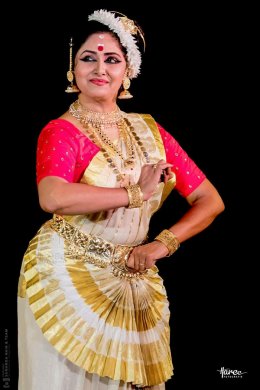 Sunanda Nair 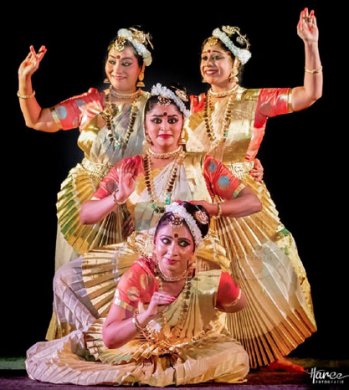 Sunanda Nair's group Their swinging, synchronized movements, basic stance of Mohiniattam and pleasant expressions were impressive. The iconic image of Lord Ganesha, his vehicle mooshaka, his large ears, and trunk were etched out competently by the four dancers. Their entries and exits looked professional. Mohinattam as a classical dance form of Kerala has indeed crossed borders and has found devotees in far off lands. In Houston since past ten years, Sunanda has been conducting classes offering training to young and not so young enthusiastic dancers. That her four disciples specially travelled to participate in Soorya Festival speaks for their love for the dance and desire to perform in Kerala before a knowledgeable audience. For the past more than 50 years one has been noticing the vertical growth of the dance form. It is heartening to see its horizontal growth globally. Sunanda in her solo enacting abhinaya to Swati Tirunal's padam in Punnagavarali raga and mishra chapu tala succeeded with her mukhajabhinaya, registering subtle nuances, almost conversing with her eyes with her beloved, simile comparing nayika's face with lotus, but almost fading - and nayaka telling her to regain her composure for the lotus would indeed bloom. As a pragalbha nayika she need not bother. The suggestions of kiss on lips, embrace, and love play were enacted with consummate artistry. The repertoire as devised by her guru Kanak Rele includes depiction of Ashtanayika as described in Bharata's Natyashastra. Sunanda has reconstructed it for group performance dividing depiction among four dancers, moving from one to another nayika, narrating the state nayika is seen vis-à-vis nayaka, in eight categories. From Swadinabhartrika to Abhisarika, in quick succession they move. Set to Ragamalika and talamalika, the depiction was as per the Natyashastra shlokas, with appropriate bhavas. Kalahantarita, estranged after a quarrel, Vipralabdha, in separation, Khandita, when hurt by infidelity of the nayaka, and in gay abandon moving stealthily to meet the lover -Abhisarika were portrayed competently. The special choreographic work on Shabari by Sunanda saw her depicting Shabari's lifelong desire to have glimpse of Lord Rama in state of youth till she was old and infirm. Matanga rishi whom she had served was pleased and had assured her that she would meet Lord Rama. Sunanda recreated the physical beauty of Lord Rama with several comparisons. Eyes like lotus, eyebrows in shape of bow, ajanabahu, long arms, waist slender like waist of a lion, that paramapurusha Lord Rama she worshipped, her every heart beat resounded with his name. She collected the berries for the lord and tasted them before placing them in basket. The transformation from youth to old age was enacted in a telling manner. And when Lord Rama arrived she was overjoyed. With arms atremble she offered the berries to Rama who accepted with affection and blessed Shabari. As a lowly birth devotee, Sunanda brought Shabari's character alive in its various hues. The four dancers performed pure dance number in panchari tala with rhythmic variations, coming together and spreading out, dancing in various formations. Sunanda concluded the performance with Jiva number. Music for majority of items was composed by late KN Panicker and also the songs were penned by him barring ashtanayika and Swati's padam. His contribution was acknowledged. Special mention must be made of the musical accompaniment. Singing by Kalamandalam Vishnu was bhavapurna, full of emotions and melodious.  Dr. Sunil Kothari is a dance historian, scholar, author and critic, Padma Shri awardee and fellow, Sangeet Natak Akademi. Dance Critics' Association, New York, has honoured him with Lifetime Achievement award. Post your comments Please provide your name and email id when you use the Anonymous profile in the blog to post a comment. All appropriate comments posted with name & email id in the blog will also be featured in the site. |